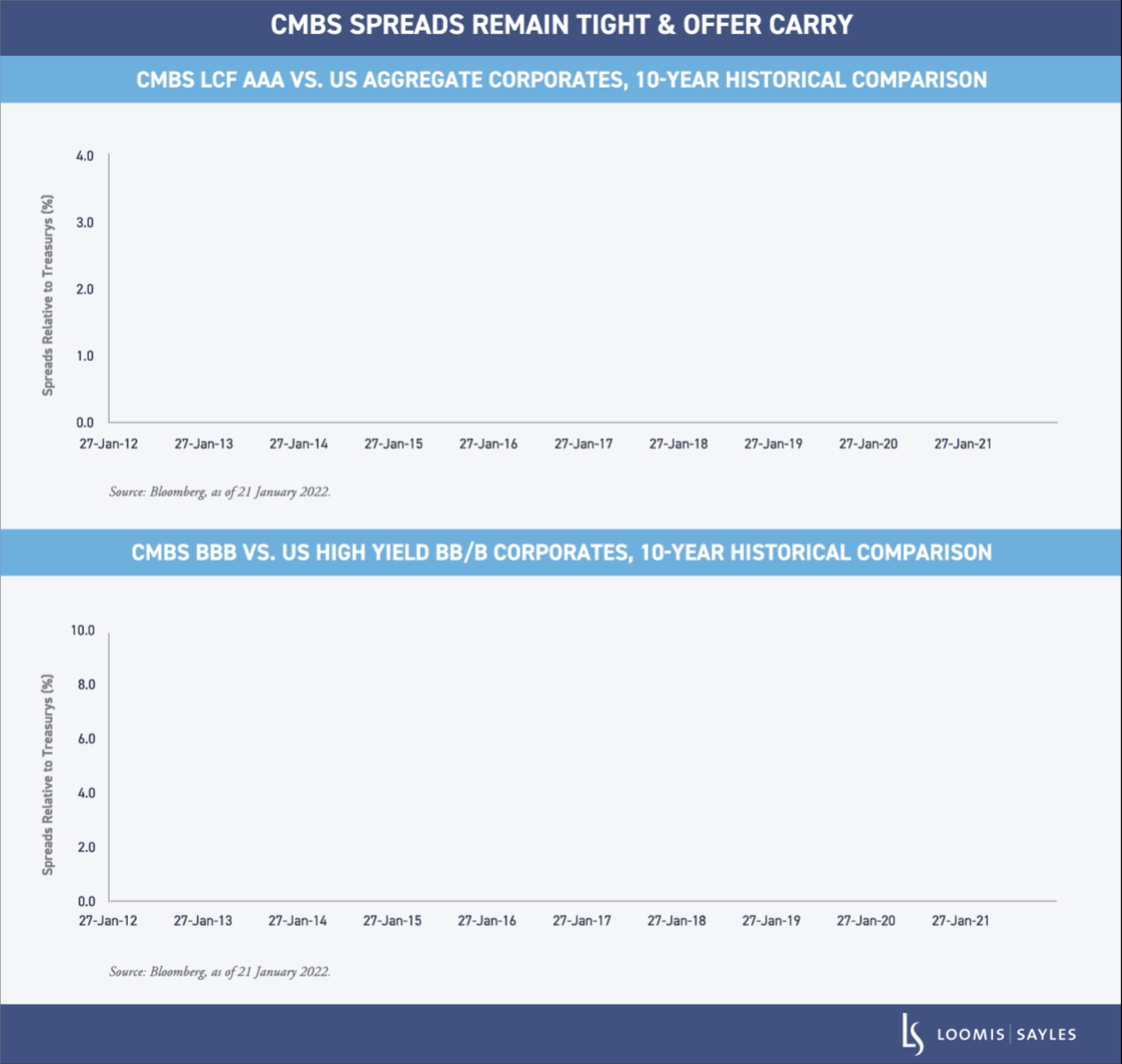1. What’s your view of securitized credit in 2022? Do you expect any impact from rising rates?
Overall, we have a positive view of securitized credit in 2022. We believe fundamentals and valuations are favorable in most areas of the securitized credit universe. Despite a broad rally in many sectors during 2021, certain areas of securitized credit have lagged and present potentially attractive entry points for investors.
We believe three characteristics of structured credit make it attractive in a rising rate environment.
- Duration: The sector’s duration, which tends to be around the three- to four-years, should benefit securitized assets relative to corporates, which typically have much longer duration. Securitized assets also currently enjoy a carry advantage relative to similarly rated corporates.
- Cash flows: Securitized assets tend to generate significant cash flows (through amortization) that can be reinvested at higher rates.
- Inflation protection: Most securitized credit sectors are either a) invested in real assets, such as real estate, that have a long history as inflation hedges, or b) backed by consumers, who are supported by wage inflation. So whether inflation and higher rates are temporary or here to stay, the combination of these factors can make structured credit attractive in uncertain markets.
In terms of risks, we acknowledge that uncertainty and heightened volatility could persist in the near term as monetary and fiscal support wanes and as the global economy grapples with COVID-19 variants. Higher inflation and, ultimately, higher interest rates could put additional strain on the consumer if wage growth does not keep pace. We believe careful subsector allocation and security selection will remain of key importance in navigating the market in 2022.
2. How do you expect the consumer sector to fare this year? Are you concerned about the impact of higher borrowing costs?
We believe consumer asset-backed security (ABS) fundamentals will remain stable in 2022 as the economy transitions from a stimulus-driven recovery to a self-sustaining expansion with the potential for higher growth, inflation and interest rates. However, we expect the recovery to remain “K-shaped.” Higher-income consumers have largely benefited over the past two years from growing asset values, increased savings and wages. This has allowed them to ride out inflation and higher interest rates more easily than others. Wage growth has likewise benefited lower-income consumers, but to a lesser extent. The loss of government stimulus and higher food and shelter prices will put more pressure on lower-income consumers’ finances than their higher-earning counterparts. Though rising borrowing costs is an issue for this group of lower-income borrowers, we have observed fewer changes to their debt servicing behavior in such an environment. We believe this is likely due to preexisting high APRs[i] based on their lower-quality credit profiles.
In recent months, we have observed signs of softness in the subprime space—specifically a rise in early delinquencies. Much of this was expected as borrowers return to "normal" subprime behavior. After nearly two years of deleveraging and very low delinquencies and defaults, consumers have started to borrow more, and we expect losses will begin to increase toward historical levels. As a result, we have observed cautious lending behavior among consumer lenders. The borrowers we’re watching most closely are those in the "near prime" space, as they tend to be the most rate-sensitive. These borrowers have improved their credit profile, yet tend to live on a tight budget; any additional pressure, such as higher borrowing costs, could result in reduced ability to service debt.
During 2021, private CRE staged a dramatic recovery. The Green Street All-Property Index increased 24% in 2021 to a level that is now 14% higher than it was before the pandemic began.[ii] Although COVID-19 variants may delay a strong rebound in asset fundamentals, we remain optimistic about the sector’s outlook for 2022. Property valuation increases during 2021 likely reflect the market’s expectations for cash flow growth and credit repair in 2022.
From a bond valuation perspective, CMBS spreads are currently at historically tight levels, but we believe they offer attractive carry relative to comparably rated corporate sectors. In addition, we see pockets of distressed retail and lodging properties that still provide discount pricing for seasoned subordinate bonds. Some of those bonds will cure, making this an interesting market for security selection in CMBS in our view.

[i] Annual percentage rate (APR) refers to the yearly interest generated by a sum that's charged to borrowers or paid to investors.
[ii] Source: Green Street, 7 January 2022.
MALR028526
Past performance is no guarantee of future results.
Market conditions are extremely fluid and change frequently.
Market conditions are extremely fluid and change frequently.
This blog post is provided for informational purposes only and should not be construed as investment advice. Any opinions or forecasts contained herein reflect the
subjective judgments and assumptions of the authors only and do not necessarily reflect the views of Loomis, Sayles & Company, L.P. Information, including
that obtained from outside sources, is believed to be correct, but Loomis Sayles cannot guarantee its accuracy. This material cannot be copied, reproduced or
redistributed without authorization. This information is subject to change at any time without notice.




